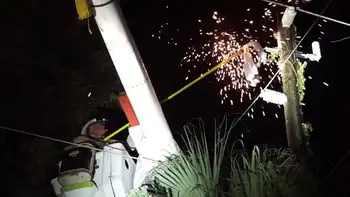Move over muscle – auto show celebrates Volt and Prius
By Globe and Mail
CSA Z462 Arc Flash Training - Electrical Safety Essentials
Our customized live online or in‑person group training can be delivered to your staff at your location.

- Live Online
- 6 hours Instructor-led
- Group Training Available
Until very recently, the global auto industry did not see green cars as the key to building brand awareness and status. Fuel economy, low emissions, and low-drag aerodynamic designs with a focus on fuel efficiency were not vehicle attributes around which a carmaker found success promoting itself, a brand or even an individual model.
The halo cars, the vehicles that excited enthusiasts and the regular buying public alike, have been for decades the product of a familiar formula: lots of horsepower, sexy styling, bold colours and big wheels.
Think Dodge Viper in the early 1990s. Chrysler back then used the Viper as a metaphor for the whole company — a company boldly reinventing itself into what became for a short time in the mid-1990s a daring, envied and highly profitable car company.
No matter that Chrysler's bread-and-butter model in the 1990s was the K-car-based minivan. No, the Viper — Detroit's answer to an exotic Italian sports car — was what Chrysler argued really best represented the company. The Viper roared with the sounds of a modified V-10 truck engine and those noises poured from side pipes that grew red-hot after just a few minutes of impressing the neighbours. There is still a place for Vipers, but it's slowly, steadily diminishing in importance for the future of full-line car companies around the world. In truth, the Vipers of the world are becoming artifacts of the auto industry's past. The new halo cars are designed to send a very different message — a green message.
First among them is the Toyota Prius hybrid hatchback. It's not particularly pretty and it's certainly not Viper-sexy, but in the past decade the Prius has been a world leader in creating a green image for Toyota — even as Toyota's product line expanded to include gas-guzzling trucks such as the Tundra pickup and luxury cars like the Lexus LS460.
The Prius, which blends gasoline and electric drive trains, is the new breed of halo car and, in the decade since it was launched, Toyota has managed to sell about one million of them. The third-generation Prius had its Canadian debut at the Canadian International Auto Show, which opened in Toronto.
The success of the Prius prompted executives at General Motors to completely re-think their approach to hybrids and electric cars — and to halo cars, in fact. And that led GM to the Chevrolet Volt extended range electric car. GM, at its 100th anniversary celebration last fall, said the future of the company rests on the success of the Volt — due for sale in late 2010.
"The electrification of the automobile is absolutely a foregone conclusion," said GM vice-chairman Bob Lutz, who heads all product development at GM.
Lutz and GM have made a complete 180-degree turn on green cars, and to see them use the Volt as a halo car for the whole company is shocking for anyone who has followed GM's fortunes closely over the years. GM, after all, was the Corvette company, not the Volt trailblazer.
Half a decade ago, when the Prius was still struggling to gain traction in the marketplace, Lutz commonly dismissed hybrid cars as expensive money losers. So did Nissan CEO Carlos Ghosn, whose company now has a very aggressive electric car program in place. With two distinct power trains and expensive batteries and controllers, hybrids made no economic sense, argued Lutz and Nissan CEO Carlos Ghosn and others. If they made no sense for owners to drive, they made no sense for car companies to produce.
In short, the fuel savings were not big enough to offset the extra $4,000 or so hybrid price premium. Then as the Prius caught on, as it became the face of Toyota — the company's signature halo car — Lutz and his GM colleagues got the message. Lutz and Ghosn and others have now seen that the Prius was not just an investment in technology, but a valuable marketing tool for Toyota.
Lutz, father of the Viper in a previous life as president of Chrysler, is now the godfather of the Volt. The 75-year-old Lutz has vowed to stay on the job at least until the Volt becomes a for-sale production model. He has made a complete and compelling public conversion to a new vision of the auto. Yes, it's electric.
"Fossil fuels are a finite resource," he says, matter-of-factly.
The Volt, which runs exclusively on lithium ion batteries which can be recharged through a wall socket or by a small on-board gasoline motor, "eliminates range anxiety" for drivers who fear running out of battery power. On pure batteries, Lutz says the Volt prototypes now being tested are delivering a consistent range of about 40 miles or 64 kilometres.
The Volt, the Prius, Ford's soon-for-sale 2010 Ford Fusion Hybrid, the 2009 Honda Insight hybrid — these are the new halo cars of the 21st-century auto industry. They have super-clean drive trains that answer fears about global warming, ever-stricter government emissions and fuel economy rules. The new green cars also answer energy security worries in countries such as the U.S. and Japan that rely on oil supplies controlled by unstable regimes.
At this year's CIAS industry executives and show organizers are putting a spotlight on the new halo cars — cars powered by something other than petroleum.
The Volt will be there, and so will the Prius. Honda's Insight, which is expected to be the least expensive production hybrid for sale in North America, will get its regional debut, too. Honda will also have a hydrogen-powered concept car on hand, BMW its 7-Series ActiveHybrid, and Mitsubishi its i-MieV electric concept.
These and others like them are the new halo cars. And like all halo cars, when running production versions come to market, most will be priced higher than regular, old gasoline-powered cars of similar size and performance. The Volt, for instance, will have a price estimated to be close to $40,000, though GM has not made anything official, yet.
Other electric hybrid and all-electric vehicles will be sold with a price premium, too. We'll know exactly how much as early as next year when this new wave of electric and hybrid halo cars come to market.
For instance, Ford Motor Co. announced that is has named Johnson Controls-Saft as its battery supplier for its 2012 plug-in electric hybrid vehicle. Ford, like GM and Nissan, is also establishing partnerships with utilities and local governments to create the electric vehicle infrastructure needed to support electric cars. Halos need support, after all.
Nissan's Ghosn, for his part, says the electric vehicle represents a breakthrough for the auto industry, if the right pieces are put into place. Ideally, by 2020, he envisions as many as seven million pure electric vehicles being sold around the world. That figure represents about 10 per cent of the 70 million new passenger vehicles being sold globally today. Today's halo cars become tomorrow's mainstream transportation, in other words.
Governments are a driving force behind the auto industry's shift as represented by the electric and hybrid halo cars that are front and centre here at the auto show in Toronto, and elsewhere across North America, Asia and Europe.
The Canadian and U.S. governments have already put in place dramatic fuel economy requirements for auto makers, but the Obama administration in Washington appears to be readying a number of other policies that could remake the auto industry even more thoroughly and more quickly.
What happens in the U.S. will happen in Canada. Prime Minister Stephen Harper has said the Canadian Government will have fuel efficiency and emissions standards that match American ones.
Automakers, for their part, want a single tailpipe emissions standard, rather than the regulatory patchwork that could emerge if the U.S. Environmental Protection Agency (EPA) approves the request of California and 12 other U.S. states to impose a 30-per-cent reduction in tailpipe emissions by 2016. President Barack Obama has directed the EPA to revisit that request, after it was denied under his predecessor, George Bush. Obama has alsodirected the U.S. Transportation Department to set higher fuel efficiency standards for the 2011 model year by March 30, which again will have an impact on vehicles sold in Canada.
The auto industry's embrace of the new green halo cars also reflects the need for them to address Obama's campaign pledge to have one million plug-in vehicles on the road by 2015. In other words, a million halo cars on the road within six years.
That would be a stretch. There are currently no plug-in or all-electric vehicles being mass produced, although there are a few start-up companies or companies offering battery conversion kits. In fact, Toyota's Bill Reinert, national manager of advanced technology, says it's not realistic to have one million plug-in vehicles on the road by 2015.
To reach the one million goal, the marketplace would need to adopt plug-ins faster than the Prius. Given the economic climate and the technology demands, that is very unlikely, he says.
But a smaller volume fleet of halo plug-ins, says Toyota's Reinert, is not just a possibility, but a probability. By January 2010, Toyota will have a test fleet of 150 plug-in vehicles on the road.
Ford has built 11 electric hybrid Ford Escapes and delivered one last month to a Detroit utility company for testing and data collection. Ford's plan is to build at least 5,000 plug-in vehicles yearly starting in 2012.
Ford also announced last month it plans to unveil an all-electric small car in 2011 with a range of about 160 km miles and an electric commercial van in 2010.
GM also has plans that go beyond the Volt. The company expects to sell a plug-in hybrid electric vehicle (PHEV) version of the Saturn Vue compact SUV in late 2010 or early 2011.
If the Saturn brand has been sold or discontinued, as GM has hinted, another GM brand would sell the PHEV. Chrysler, too, says it will sell battery-only vehicles in North America in 2010.
All these electric cars, even when sold in halo-like numbers, will require help in terms of infrastructure. Britta Gross, GM's manager of hydrogen and electrical infrastructure development, says cities can offer things like providing access to high-occupancy vehicle lanes, waiving sales tax, and providing some public charging stations.
"We've put together a blueprint of who can do somethingÂ… and what could they do to create an environment that is much, much more conducive" to plug-in vehicles, she says.
All these moves and others add up to an auto industry at work trying to put a green halo over its future. So long Viper, hello Volt and Prius, and all the rest.











